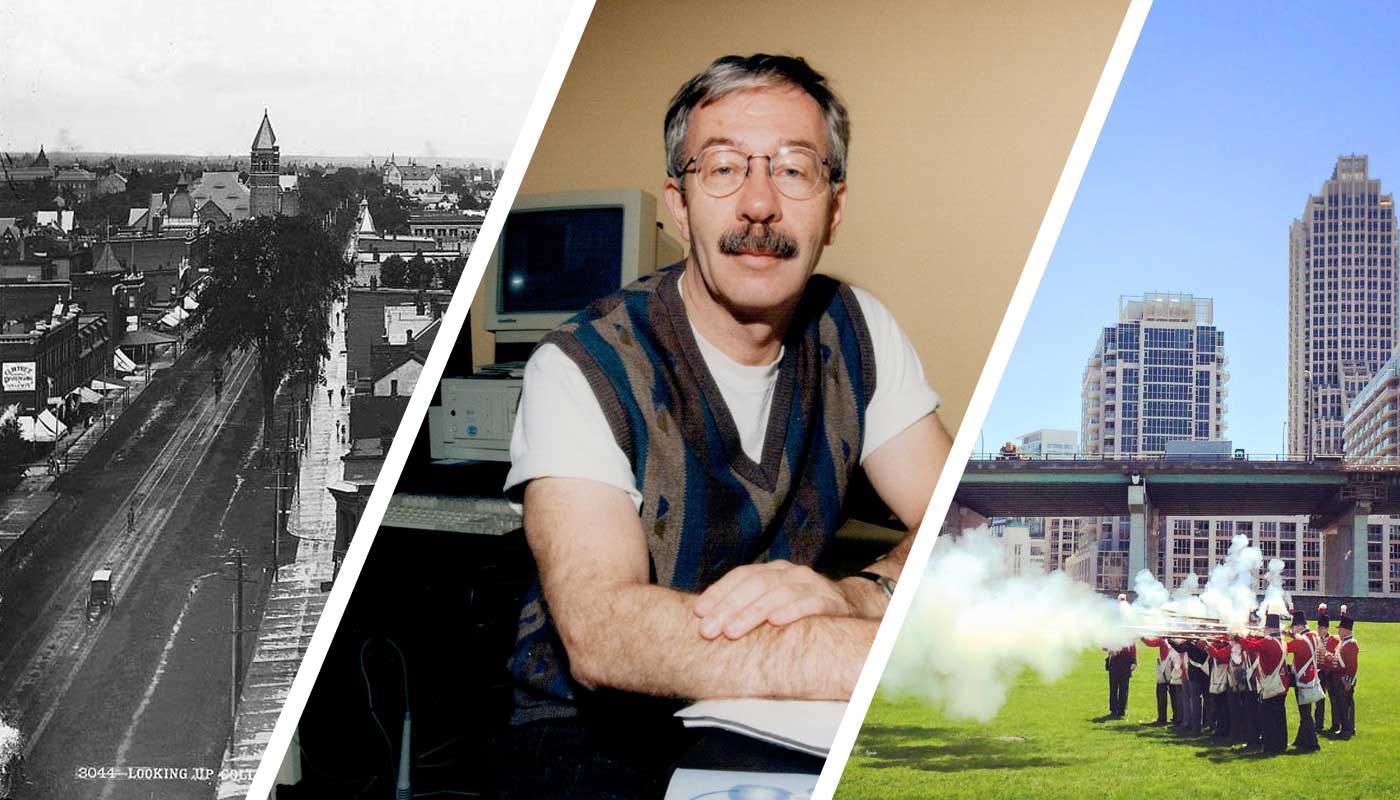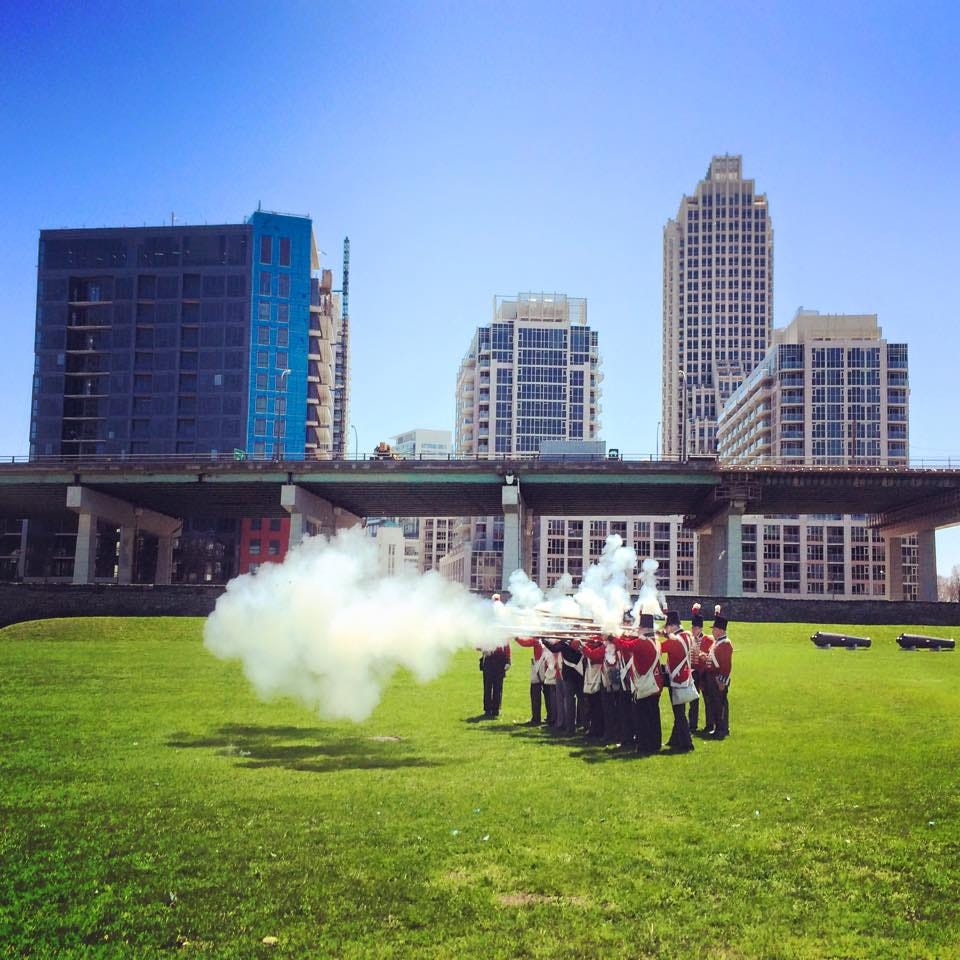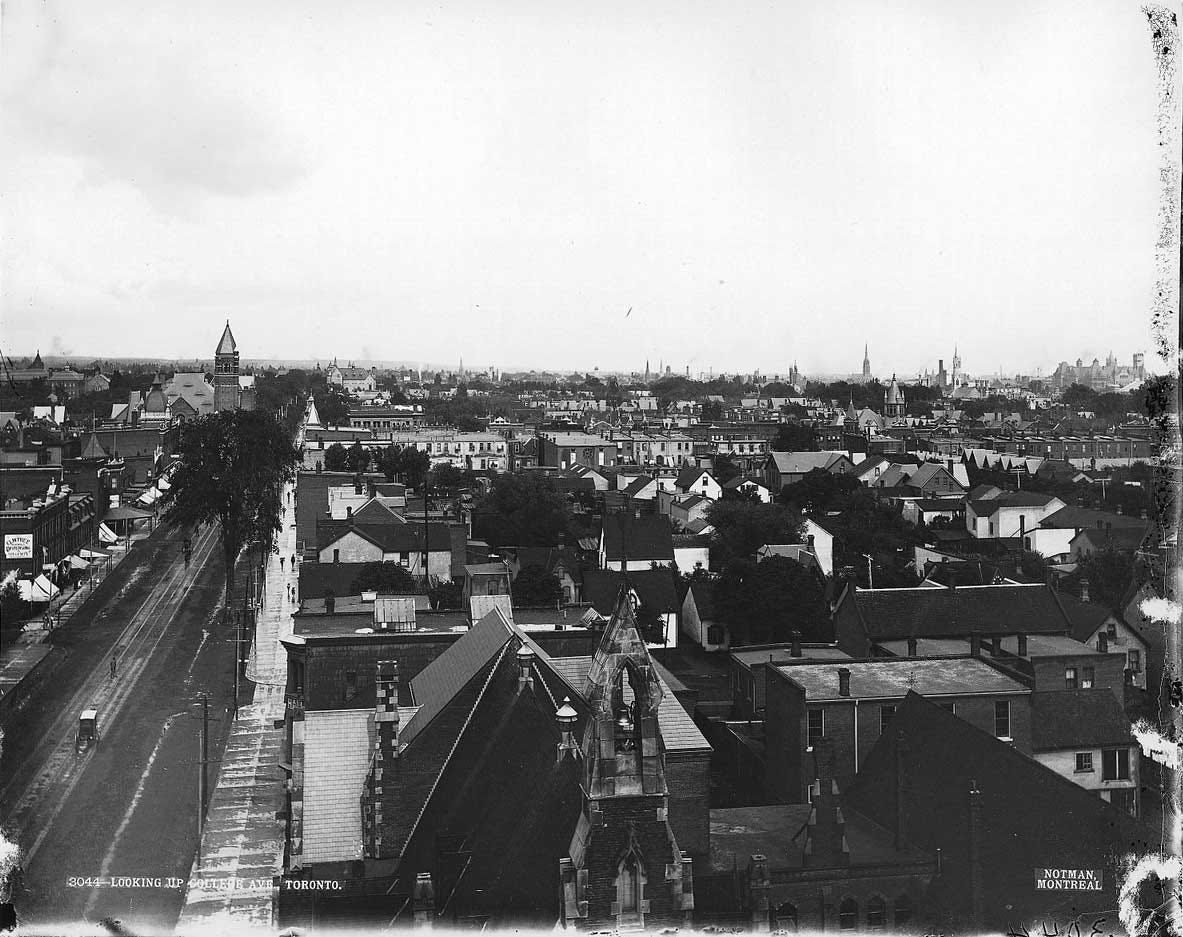Fort York Loses Its Guard
Plus Toronto loses a gay liberation leader, a big old tree in the middle of the street, and more.
During this week in 1880, George Brown died. The Father of Confederation and publisher of The Globe had been shot by a drunken and disgruntled former employee seven weeks earlier — which I wrote about in the newsletter back in March — and finally succumbed to his infected wound at the beginning of May.
This week in 2022, we’ll talk about the loss of one of the most beloved features of Fort York, an old elm tree that used to stand right smack dab in College Street, the passing of one of Canada’s most infamous journalists, and more.
But before we begin, I wanted to let you know that I’m planning to announce an online talk soon as an exclusive little thank you for those of you wonderful people who’ve switched to a paid subscription. It keeps this newsletter going and supports all the work I do in sharing stories from the history of city.
For The Toronto History Weekly to keep going, lots of you will have to make the switch, which you can do here:
Thanks to everyone who reads, subscribes and spreads the word!
FORT YORK IS LOSING ITS GUARD
MUSKET FIRE NEWS — It’s been just a couple of weeks since we got some wonderful news about Toronto’s city-owned museums: all ten have switched to free admission. (You can read my favourite stories and facts about each of them here.) But this week, there was much less exciting news about one of those museums: The Fort York Guard will not be returning this year.
The Guard has long been one of the most evocative sights at the fort. Student volunteers in bright red and green uniforms provide musket and artillery demonstrations, fill the air with the sounds of their drums, and help bring the history of the fort to life. They’re one of the most memorable and iconic parts of a trip to the old fort, a striking visual connection to its early years as a military stronghold in the late 1700s and early 1800s.
The origins of today’s Guard go all the way back to the 1930s, when Fort York first opened as a tourist attraction. In recent decades, they’ve been run by the Friends of Fort York and Garrison Common. But this week, that group announced on Facebook that they “have not been able to obtain support from the City to operate the Fort York Guard this summer.”
It’s not clear if the Guard is gone forever though. The future still seems to be up in the air. To questions posted on social media, the Friends of Fort York and Garrison Common replied, “Toronto History Museums is re-evaluating partnerships and programmes generally. The Guard is one of them. We will provide further updates when appropriate.” So, hopefully it’s just a bit of a transition period and the sound of musket fire and drums will return.
But in the meantime, while Fort York will be free this summer, it will also be missing one of its most iconic draws.
AN ELM TREE IN COLLEGE STREET
BADASS FLORA NEWS — If you aren’t already following Eric Sehr on Twitter, you probably should be. He seems to pop up in this newsletter every week with some nifty new discovery. And this week he shared one of his most remarkable finds yet.
This photo was taken in the late 1800s. That’s College Street running up through the left-hand side of the image. We’re looking east from high atop the fire hall that still stands on that stretch of road between Bathurst and Spadina. Kensington Market is laid out before us.
And if you look closely at College Street, just a couple of blocks up, you’ll notice the towering dark shape of a big old elm tree standing next to the wooden sidewalk. The extraordinary thing about it? It’s standing right there smack dab in the middle of a lane of traffic.
The elm tree was, of course, a local landmark. It stood there in the road until 1911, when it was finally brought down. According to the newspaper report Sehr shared on Twitter, the tree had been there longer than anyone could remember, thought to have been at least a century old — which suggests that it very well may have been older than the city itself.


SAYING GOODBYE TO “ONE OF CANADA’S MOST INFAMOUS JOURNALISTS”
SAD NEWS — Gerald Hannon died this week, choosing to end his life with medical assistance at the age of 77 as he suffered from Parkinson’s disease. He was one of the giants of our city’s LGBTQ+ history, a journalist, professor, sex worker and activist, and one of the editors of the pioneering journal, The Body Politic. His work often sparked controversy and outrage: after publishing his 1977 article about men dating underage boys, The Body Politic was charged with distributing “indecent, immoral and scurrilous literature” (it was acquitted), and Hannon’s honesty about his sex work made front page news and got him fired from his job teaching at Toronto Metropolitan University (still called Ryerson back then, of course). Xtra calls him “one of Canada’s most infamous journalists” and “a key figure in the gay liberation movement.”
His writing provides a vital record of Toronto’s LGBTQ+ history over the last few decades, and his work has served as a source for my own: Hannon appears in the bibliography of The Toronto Book of the Dead and he was a contributor to Any Other Way: How Toronto Got Queer, which was the very first book I read when I began to work on The Toronto Book of Love.
His close friend, Ed Jackson, wrote a tribute for Xtra this week, which is a very good place to start for anyone who wants to understand Hannon’s life and work, and the role he played in our city.
READ TWO OF HANNON’S ESSAY FROM ANY OTHER WAY: HOW TORONTO GOT QUEER PUBLISHED BY SPACING MAGAZINE THIS WEEK
QUICK LINKS
The best of everything else that’s new in Toronto’s past…
CASTLE NEWS — The private company that leases Casa Loma from the City has been accused of starting to build a new restaurant there without any public consultation or a Council vote. The plans have now been scrapped. Read more.
SECRET POLICE NEWS — Jamie Bradburn writes about the wild 1945 Ontario election, filled with xenophobia, antisemitism, misogyny and secret police as the Conservatives claimed the forerunner of the NDP was trying to turn Canada into the Soviet Union. Read more.
CANDLE BULLET NEWS — Eric Sehr uncovered another bizarre bit of news this week:


BROCKTON VILLAGE NEWS — …and he also gave a virtual Twitter tour about the history of Brockton Village based on the Jane’s Walk he led last weekend. Read more.
THE CANADIAN GOD DOESN’T LIKE DRINKING NEWS — Gil Meslin found a paragraph written in The Globe and Mail 57 years ago that applies pretty well to this week’s decision by City Council to continue making drinking in parks illegal. (A subject I’m hoping to write some more about myself soon.)


MOB HIT NEWS — Peter Edwards shares the story of a Toronto mobster who was murdered in 1997, shot in the head and dumped in a trunk after a life of crime that included getting his leg blown off by a shotgun. Read more.
DEGRASSI NEWS — Back in January, I shared the story of the original De Grassi kids and their role in the rebellion of 1837. This week, Retro Ontario’s Ed Conroy explores the early roots of the Degrassi television franchise that got its name from the road named after their family. Read more.
FRENCH FORT NEWS — Jack Landau takes a brief look at the history Fort Rouillé, which was built as a trading post in the 1600s at the place where the Exhibition Grounds are now. Today, you’ll find its old walls outlined in the ground. Read more.
COCKROACHES NEWS — Toronto Life takes a look at the Rolling Stones’ 1977 shows at the El Mocambo, played under a false name and sound to be released as a live album. Read more.
CHOO CHOO NEWS — The Toronto Guardian chats with Kelly Burwash, manager and curator of the Toronto Railway Museum, which you’ll find downtown next to Steamwhistle and the SkyDome. Read more.
DOORS OPEN
TORONTO HISTORY EVENTS
1851: SPIRIT & VOICE
May 18 & June 8 — 7pm — Online — Myseum
“Back by popular demand! Welcome to 1851: Spirit & Voice, a theatrical and playful revisiting of the 1851 North American Convention of Coloured Freemen. Through this new work written by playwright Luke Reece, step into the world of a fictionalized digital conference where the past and present collide.
“Live from St. Lawrence Hall, Marie and Anthony host a retrospective look at the gathering of 19th century abolitionists in Toronto, when their event is crashed by ghosts of conventions past. Together our characters grapple with the way history has been written, as well as issues that affect Black lives today. Watch leading historical figures Mary Ann Shadd Cary, Henry and Mary Bibb, and Frederick Douglass share their unfiltered thoughts on historical storytelling and 21st century anti-Black racism.”
Free with registration.
Learn more & register for the May 18 presentation or the June 8 presentation.
ROYAL TRAIN TOURS OF CANADA IN THE REIGN OF ELIZABETH II
May 19 — 7pm — Online — Toronto Railway Museum
“We’re so excited to announce Royal Train Tours of Canada in the Reign of Queen Elizabeth II, our upcoming online lecture! Author and royal historian Dr. Carolyn Harris will profile our country’s rich royal ties to traveling by rail with an overview of royal tours of Canada.
“Although train travel across Canada was no longer central to royal tours of Canada after the 1950s as air travel took centre stage, short royal train journeys and engagement with railway history continued to be part of Canadian royal tours as the Queen rode the monorail train at Expo 67, and took a historic silver jubilee train journey from Ottawa to Wakefield, Quebec in 1977. William and Catherine visited the White Pass steam train in Carcross, Yukon during their most recent Canadian tour in 2016.”
Free with registration.
FREDERICK BANTING… THE MAN YOU THOUGHT YOU KNEW
May 19 — 7:30pm — Online — Etobicoke Historical Society
“Frederick Banting once wrote, “Insulin was but a means to an end.” After receiving Canada’s first Nobel Prize, insulin did become a means to an end. Unfortunately for Banting, that end was a legacy from which he desperately attempted to distance himself.
“The story of Frederick Banting is well known, but not necessarily known well. While his name has become synonymous with the discovery of insulin, there was far more to this distinguished Canadian’s career than the often-simplified events of the insulin period. Grant Maltman will highlight insulin’s centenary and introduce other aspects of his life and career including his service in both World Wars, his use of art as an escape, and his role as a catalyst for Canada’s military and medical research programs.”
Free for members; an annual membership is $25.
THE MAPLE LEAF MYSTERY CONFERENCE: IT REALLY HAPPENED TRUE CRIME PANEL
May 24 — 8:15pm — Online — Maple Leaf Mystery Conference
“True crime stories from Canada and around the word including cold cases, unsolved murders, killers and monsters, gangster and the havoc they create.” A panel of Canadian authors talking about true crime stories, including two writers from Toronto: Nate Hendley, author of The Beatle Bandit: A Serial Bank Robber's Deadly Heist, a Cross-Country Manhunt, and the Insanity Plea that Shook the Nation, and Lorna Poplak, author of The Don: The Story of Toronto’s Infamous Jail.
$25 for the entire conference.
HISTORY OF TORONTO’S CHINATOWNS: A WALK IN TIME 1850–2022
May 25 — 7:30pm — Online — The North Toronto Historical Society
“NTHS member Harvey Low will take a walk through time examining the Chinese population and the different Chinatowns in Toronto, using census data and photos. His presentation will showcase archival photos alongside present-day locations, while also highlighting some of the social challenges that this community faced while integrating into Canadian society. Harvey holds a degree in Urban Studies from Ryerson University, with an emphasis on urban history and demographics. He recently retired after 35 years in municipal government as Manager of the Social Policy & Research Unit. He is a 4th generation Chinese-Canadian with handed-down knowledge of the Chinese Community here in Toronto.”
Free with registration, I believe.
DOOR OPEN TORONTO
May 28–29 — 10am to 5pm each day — More than 100 buildings around the city
“Explore Toronto’s Buildings & Sites. Rediscover the city you thought you knew through Doors Open Toronto, celebrating 100+ sites of architectural, cultural and social significance. Go deeper with engaging tours, insightful talks, an online film series and other virtual experiences.”
Free!
DEATH OR CANADA: THE IRISH FAMINE MIGRATION TO TORONTO, 1847
May 31 — 6:30pm — Online — Enoch Turner Schoolhouse Foundation
“This year marks the 175th anniversary of Irish Famine migration to Canada. Join author and historian, Professor Mark McGowan, as he shares his work Death or Canada: The Irish Famine Migration to Toronto, 1847. Discover the impact this historic event had on the city and hear stories of the men and women who made the perilous sea voyage to Canada.” The talk will follow the foundation’s annual general meeting.
Free with registration, I believe.
RECONCILIATION: IS IT WHAT YOU THOUGHT?
May 31 — 6:30pm — Online — Riverdale Historical Society
“An in depth look at inequality, mythology, discrimination and action. The importance of history and learning while working toward reconciliation with tie-ins to work that the First Nations Child and Family Caring Society has done to highlight Dr. [Peter] Bryce’s legacy, as 2022 will be the 100th anniversary of the publication of ‘A National Crime’” his whistle-blowing report on the residential school system.
With Cindy Blackstock, a member of the Gitxsan First Nation, Executive Director of the First Nations Child and Family Caring Society, and a professor at McGill University’s School of Social Work.
Free, I believe, if you join the Riverdale Historical Society’s mailing list.
ERNEST D. BANTING’S LIFE IN WESTON
June 16 — 7:30pm — Online — Etobicoke Historical Society
“Ernest D. ‘Doc’ Banting (1892-1973), a distant cousin to Dr. Frederick Banting, discoverer of Insulin, was a leading citizen of the Town of Weston in the mid-1900’s. As a salesman and politician in a career that spanned more than five decades from the 1920s to the 1970s, ‘Doc’ was a shameless self-promoter but a constant home-town booster … and a bit of a rogue.
“Join EHS Historian Richard Jordan as he follows ‘Doc’ around the town while exploring topics like small town sports, municipal politics, the Orange Order, the effects of the Depression, the birth of Canada’s unemployment system, the role of service clubs like the Lions and, last but not least, temperance. Vividly recreating a community from a vanished era, Richard will draw on research from his newly-published book, Ernest D. Banting and Life in Weston 1921-1973.”
Free for members; an annual membership is $25.









